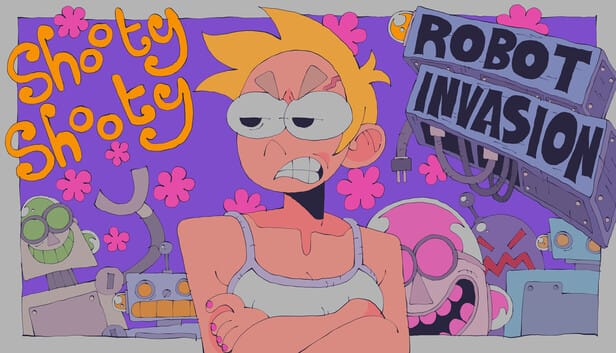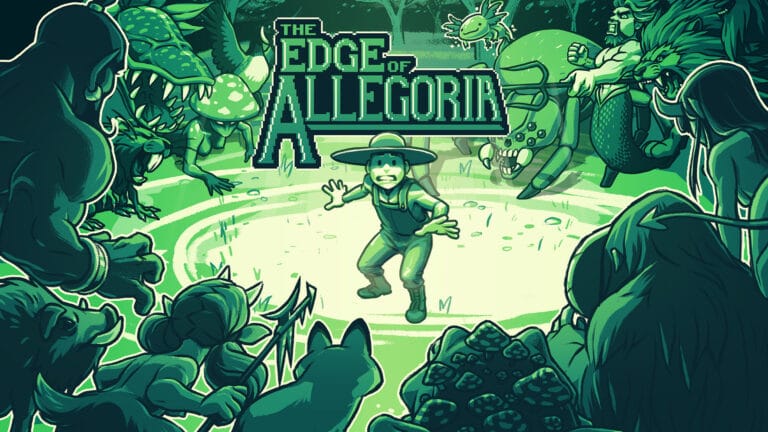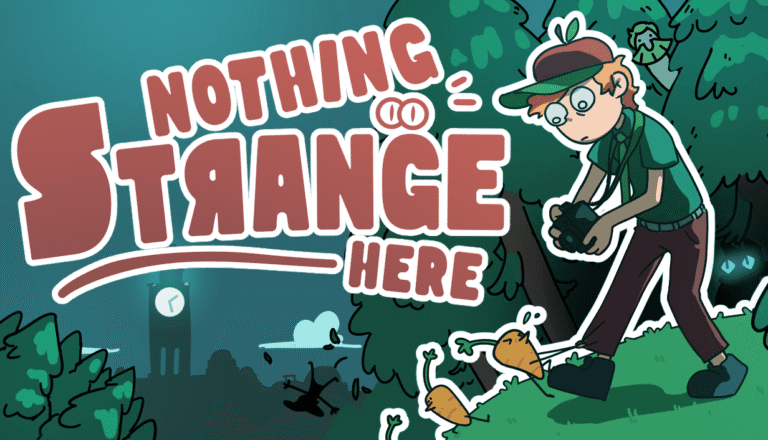
I’ll be honest when I first saw “Shooty Shooty Robot Invasion” pop up on Steam, everything about it screamed “cheap indie cash grab”. The title alone made me roll my eyes, and the marketing description promising to let me “murder stupid robots” and “chat with idiot people” didn’t exactly inspire confidence. But sometimes the games that look the most ridiculous on paper end up surprising you the most.
When Robots Attack (And You Actually Care)
What I discovered after diving into Bubby Darkstar’s creation was something genuinely special a hand-drawn FPS that manages to be both hilariously absurd and surprisingly thoughtful. This isn’t just another indie game trying to get by on quirky humor; it’s a carefully crafted experience that respects your time while delivering consistent entertainment.At its core, it’s an absurdist FPS/interactive fiction hybrid where you play as Shooty, a “Certified Cool Girl” tasked with stopping a robot invasion in the bizarrely named location of Califlorida.
Drawing Outside the Lines (Literally)
What immediately sets “Shooty Shooty Robot Invasion” apart is its commitment to hand-drawn animation. Every frame has been painstakingly illustrated and animated by Bubby Darkstar, creating a visual experience that feels like watching an interactive Saturday morning cartoon albeit one with considerably more profanity. The dedication shows in every explosion, character interaction, and environmental detail.
The gameplay mechanics are deliberately minimal: you have dual-wielding pistols, a dash ability, and what the game calls a “bastardised Tiger Uppercut” for parkour. There are no health drops during combat, no complex weapon trees, no progression systems just pure skill-based shooting. This stripped-down approach initially frustrated me, especially when dealing with flying enemies that could overwhelm you quickly. But learning to master the dash timing and positioning became genuinely rewarding.
The People You’ll Meet (and Want to Shoot)
The real strength lies in how the game structures its six levels. Rather than linear corridors, each area presents a large, explorable space packed with NPCs, side quests, and secrets. These aren’t your typical fetch quests either you might find yourself helping someone with a birthday party, delivering an apparently crucial letter to someone named Jay, or earning the coveted title of “Certified Cool Girl”.
The over 200 characters populating this world each have distinct personalities and dialogue. What could have been throwaway interactions become genuine highlights, with writing that balances absurdist humor and surprising emotional depth. The organization you work for f.o.r.k. (Force of Robot Killers) serves as both narrative device and workplace satire.
Pew Pew Goes the Dual-Wield
While the mechanics seem basic on paper, the combat system reveals surprising depth through enemy variety and encounter design. With over 50 different robot types to face, each encounter requires different tactical approaches. Boss battles strike an excellent balance between challenge and accessibility, never feeling unfair despite the game’s unforgiving no-healing-during-combat rule.
The dual-wielding system can make you feel overpowered at times, but the game compensates with smart encounter design that keeps fights engaging. The parkour elements, while initially tricky to master, add verticality to combat encounters and create satisfying movement flow.
When Pixels Don’t Apply
On PC, the game runs smoothly with modest system requirements you’ll need Windows 10, a multi-core 2 GHz processor, 4 MB RAM, and an Nvidia GTX 750 or equivalent. Despite its hand-drawn aesthetic, the optimization is solid, maintaining consistent performance even during chaotic multi-robot battles. The audio design perfectly complements the visual chaos, with weapon sounds and voice acting that enhance rather than overwhelm the hand-drawn presentation.
Bang for Your Buck (and Robots)
At $9.99 (frequently discounted to $6.99), the game offers substantial value for its price point. The developer estimates 6-10 hours of content, though thorough exploration can extend this significantly. While there aren’t traditional difficulty settings or extensive replay mechanics, the dialogue variations and hidden content provide incentive for multiple playthroughs.
Playing Well with Others (In the Genre)
In an indie gaming landscape saturated with pixel art throwbacks and derivative mechanics, “Shooty Shooty Robot Invasion” carves out a unique identity. The commitment to traditional hand-drawn animation immediately distinguishes it from contemporaries, while the interactive fiction elements create a more narrative-focused experience than typical FPS games.
The game succeeds by focusing on what it does well rather than trying to compete with AAA productions on technical spectacle. It’s a reminder that creativity and personality can triumph over budget limitations when applied with genuine care and vision.
The Robot Revolution Has Some Glitches
The game isn’t without limitations. Six levels, while densely packed, may leave some players wanting more content. Some encounters can become visually overwhelming, making it difficult to track targets amid the chaos. A few minor technical hiccups have been reported, though these don’t significantly impact the overall experience.
Final Score: 3.8/5
The Verdict: Resistance is Futile
“Shooty Shooty Robot Invasion” succeeds because it commits fully to its absurdist vision while delivering solid gameplay fundamentals. Bubby Darkstar has created something that feels genuinely fresh in a genre often dominated by formula and expectation. The overwhemingly positive Steam rating isn’t just about novelty it reflects a game that respects both player intelligence and time investment.
For less than ten dollars, you’re getting access to a genuinely unique gaming experience that stands apart from the crowd. It’s not trying to revolutionize the FPS genre, but it doesn’t need to. Sometimes being memorable, entertaining, and authentically creative is more than enough.
A charming, creative FPS that proves indie games can still surprise and delight with the right combination of vision and execution.
This review of SSRI is based on the PC version, with a code provided by the game’s publishers.


